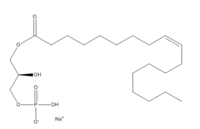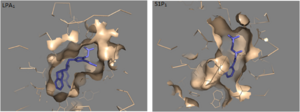Sandbox Reserved 1175
From Proteopedia
(Difference between revisions)
| Line 25: | Line 25: | ||
===Pain=== | ===Pain=== | ||
LPA, a signaling phospholipid, that attaches to three specific G-protein-coupled receptors. After an injury occurs LPA is released in the body. It then will activate G-protein-coupled receptors. Within the nervous system, LPA plays a role in the nociceptive process (nociceptive pain is a sharp pain that can come from a mild burn or twisted ankle). The LPA signaling will activate GTPase RhoA. Once activated Rho translocates to the plasma membrane. Rho will activate Rho kinase (ROCK). Mice with the deletation of LPA<sub>1</sub> receptors were studied to see the role that LPA signaling played in pain. In a study done with mice, those without the LPA<sub>1</sub> receptor had lower levels of pain.<ref name= "Inoue"> DOI:10.1038/nm1060 </ref>. Another use of LPA is it can help in stimulation of cell migration <ref name= "Moolenaar" </ref>. | LPA, a signaling phospholipid, that attaches to three specific G-protein-coupled receptors. After an injury occurs LPA is released in the body. It then will activate G-protein-coupled receptors. Within the nervous system, LPA plays a role in the nociceptive process (nociceptive pain is a sharp pain that can come from a mild burn or twisted ankle). The LPA signaling will activate GTPase RhoA. Once activated Rho translocates to the plasma membrane. Rho will activate Rho kinase (ROCK). Mice with the deletation of LPA<sub>1</sub> receptors were studied to see the role that LPA signaling played in pain. In a study done with mice, those without the LPA<sub>1</sub> receptor had lower levels of pain.<ref name= "Inoue"> DOI:10.1038/nm1060 </ref>. Another use of LPA is it can help in stimulation of cell migration <ref name= "Moolenaar" </ref>. | ||
| - | |||
===Fibrosis=== | ===Fibrosis=== | ||
To look at the effects of LPA on fibrosis, there was a study done with mice <ref> PMID:18066075 </ref>. It was seen that with targeted deletion of LPA receptors the mice would be cured from fibrosis. Mice who had fibrosis were given LPA1 regulated LPA-induced fibroblast. Over time the mice who had fibrosis began to have their lungs repaired. The amount of fluid in their lungs decreased. | To look at the effects of LPA on fibrosis, there was a study done with mice <ref> PMID:18066075 </ref>. It was seen that with targeted deletion of LPA receptors the mice would be cured from fibrosis. Mice who had fibrosis were given LPA1 regulated LPA-induced fibroblast. Over time the mice who had fibrosis began to have their lungs repaired. The amount of fluid in their lungs decreased. | ||
Revision as of 12:23, 29 March 2016
| This Sandbox is Reserved from Jan 11 through August 12, 2016 for use in the course CH462 Central Metabolism taught by R. Jeremy Johnson at the Butler University, Indianapolis, USA. This reservation includes Sandbox Reserved 1160 through Sandbox Reserved 1184. |
To get started:
More help: Help:Editing |
Contents |
Human Lysophosphatodic Acid Receptor 1
Lysophosphatodic Acid
Function
LPA, a signaling phospholipid, can attach to three specific G-protein-coupled receptors. LPA can activate multiple pathways in particular, Ras and Pho which belong to the family of GTPases. Another use of LPA is it can help in stimulation of cell migration [1].
Structure
| |||||||||||
References
- ↑ 1.0 1.1 1.2 Moolenaar WH, van Meeteren LA, Giepmans BN. The ins and outs of lysophosphatidic acid signaling. Bioessays. 2004 Aug;26(8):870-81. PMID:15273989 doi:http://dx.doi.org/10.1002/bies.20081
- ↑ 2.0 2.1 Chrencik JE, Roth CB, Terakado M, Kurata H, Omi R, Kihara Y, Warshaviak D, Nakade S, Asmar-Rovira G, Mileni M, Mizuno H, Griffith MT, Rodgers C, Han GW, Velasquez J, Chun J, Stevens RC, Hanson MA. Crystal Structure of Antagonist Bound Human Lysophosphatidic Acid Receptor 1. Cell. 2015 Jun 18;161(7):1633-43. doi: 10.1016/j.cell.2015.06.002. PMID:26091040 doi:http://dx.doi.org/10.1016/j.cell.2015.06.002
- ↑ Inoue M, Rashid MH, Fujita R, Contos JJ, Chun J, Ueda H. Initiation of neuropathic pain requires lysophosphatidic acid receptor signaling. Nat Med. 2004 Jul;10(7):712-8. Epub 2004 Jun 13. PMID:15195086 doi:http://dx.doi.org/10.1038/nm1060


